How to grow frost-resistant eggplant "King of the North"
The King of the North hybrid does not look like other eggplants either in the appearance of the bushes or in properties. This unpretentious crop was bred specifically for cultivation in the northern regions. The vegetable does not require special care, but it brings high yields. Suitable for stewing, baking and preserving, does not need soaking.
The content of the article
Description of eggplant
Frost resistance, unpretentiousness and high yield of tasty fruits - the main features of the culture.
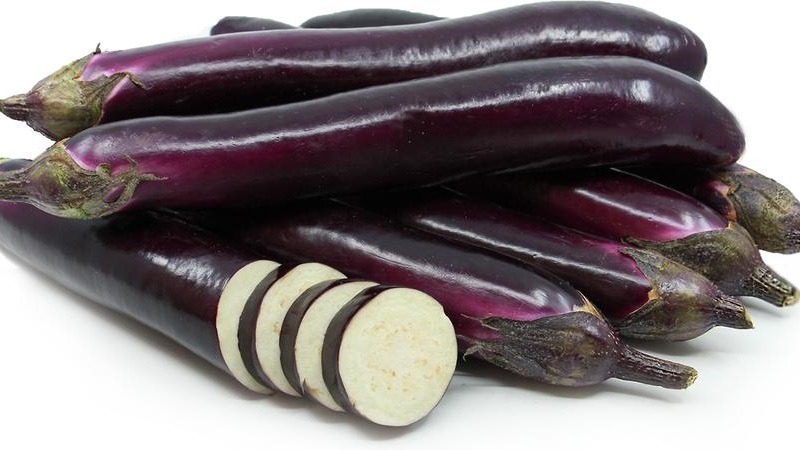
Hybrid F1
The F1 symbol in the name indicates that this is a hybrid of the first generation, obtained by crossing two parental forms of culture. This generation has unique properties.
The only drawback is the inability to remove the vegetable yourself. The harvested seeds will already be second generation hybrids and will not yield a crop with similar qualities.
Distinctive features
Features of eggplants The King of the North - its unpretentiousness and frost resistance... The hybrid bears fruit well in adverse climatic conditions.
Culture doesn't like heat and intended for breeding in central Russia and northern regions... It is successfully grown in the Urals, Siberia, Central Russia and the North-West region.
Due to its good productivity, the King of the North is cultivated not only in individual farms, but also in large agricultural complexes.
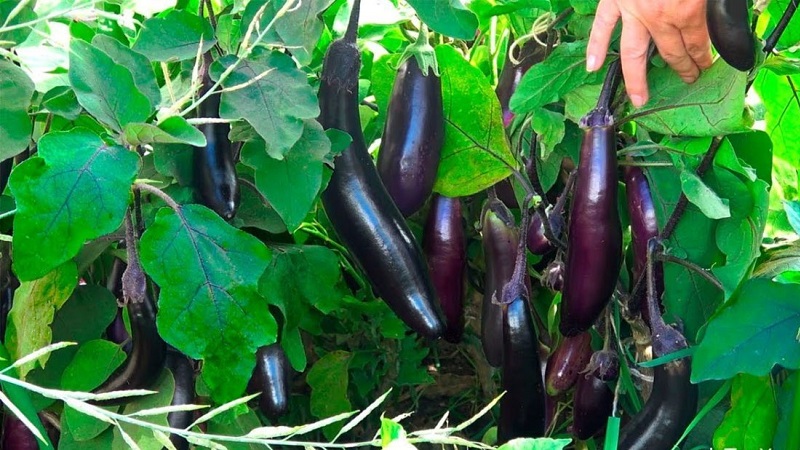
Specifications
The average height of the bushes is 0.5 m... The branches and stem are powerful and thick. In the open field, they do not need tying and additional care, but in greenhouses vegetables grow in height and width, and then it is better to tie them so that the bushes do not deform under the weight of the fruit.
Eggplant with purple skin, rather long (up to 30-40 cm), but narrow... With a low growth of bushes, the fruits often sink to the ground. The average weight of vegetables is 300 g.
White juicy pulp... It has a mild taste without bitterness. The fruits do not require soaking. Some farmers believe that the King of the North tastes like store-bought eggplant. Others like the hybrid for its lack of bitterness and versatility in cooking.
The yield of the hybrid is high: up to 10-12 kg from 1 m2... In the open field, fruiting lasts until the end of summer, in the greenhouse - until September.
How to grow yourself
For high-quality seedlings and large yields the seeds are prepared, the seedlings dive into the ground correctly, fertilize and prevent diseases.
It can be useful:
Why eggplants do not turn blue, but turn green and how to prevent it
What are white eggplants and how they differ from ordinary ones
Seed preparation and seedling growing
 The king of the north has a high germination rate, on average up to 70%. Additionally, it is increased by seed treatment. Preparation consists in warming up, disinfection and subsequent drying of the planting material:
The king of the north has a high germination rate, on average up to 70%. Additionally, it is increased by seed treatment. Preparation consists in warming up, disinfection and subsequent drying of the planting material:
- When warmed up, the seeds are placed in gauze, which is immersed in warm water (up to +40 ° C). If the water is hot, the grains will cook.
- Disinfection - seed treatment with a weak solution of potassium permanganate. Thereafter, they are washed in running water and dried at room temperature on a paper towel or towel.
- Hardening of planting material is popular, in which for a week it is put in the refrigerator overnight, and for the day in the warmest place.
- The processed seeds are wrapped in a wet, warm cloth and wait until they hatch.For this, the fabric is placed on a saucer, and it is placed next to the battery.
Seeds are planted in peat pots or boxesfilled with earth. The soil is purchased in the store (for example, intended for tomatoes: it is light and air-permeable) or you prepare it yourself. For eggplants, take 2 parts of humus, 2 parts of peat, add 1 part of sand and earth to them.
Important! For the prevention of diseases, crushed activated carbon, ash, chalk are added to the soil.
The soil mixture is additionally calcined in the oven, frozen in the freezer, and treated with steam. Moderately moisten immediately before sowing.
Seeds are distributed over the surface of the earth, without deepening them, sprinkled with soil on top. The boxes are covered with plastic wrap and placed in a warm place. It is advisable to heat them from below.
When the first shoots appear, the temperature is lowered up to + 16 ... + 18 ° C (then maintain at the level of + 23 ... + 25 ° C), but increase the level of illumination with phytolamps. Seedling care consists in moderate watering, applying complex fertilizers and hardening the seedlings before planting in the ground.
Transfer
The seedlings are ready for diving into the ground at the age of 60-65 dayswhen the soil warms up to +15 ° C. For her, they dig up and loosen the soil in advance. In the northern regions, the beds are "insulated" by introducing humus into the ground or creating an additional layer of sawdust or straw above it.

For disembarkation, choose a place protected from the wind. The king of the north does not like excessive moisture and drafts.
The bushes of the hybrid are compact - plant them at a distance of 50 cm from each other.
Further care
In the first weeks after transplant plants are protected from cold and wind by covering them with protective material. In the future, the King of the North does not need additional protection.
Hybrid loves moisture, but without excess... If there is no heat and heat, it is enough to moisten the planting once every 3 days. After irrigation, the soil is weeded, weeds are removed. Mulching the beds will retain moisture, slow down the growth of weeds.
After picking, eggplants are fed organic fertilizers, in the second half of summer - ash, superphosphate and potassium sulfate.
Features of cultivation and possible difficulties
Long fruits often grow to the ground. So that they do not get dirty and rotten, the beds are mulched, boards are laid.
For a rich harvest when grown in infertile soils the culture is fed every 2 weeks with phosphates and potassium sulfates... After fertilization, the bushes are watered so as not to burn the roots.
Instead of applying complex fertilizers, cow dung or bird droppings diluted in water are used.
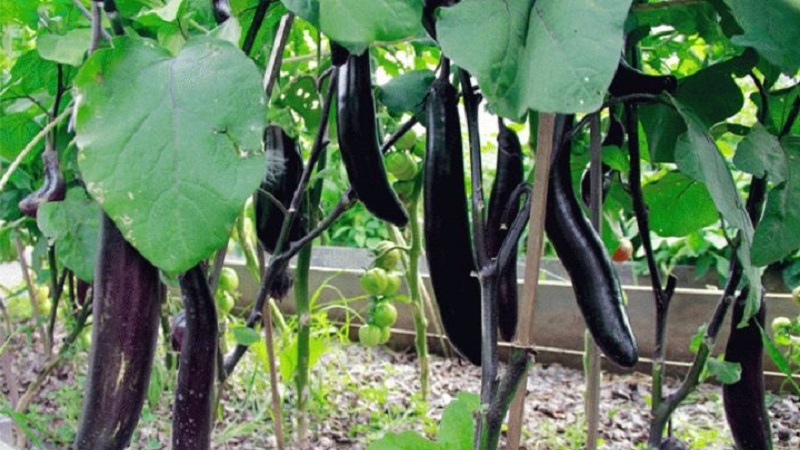
Typical diseases and pests
The king of the north is resistant to major cultural diseases due to its hybrid qualities and seed treatment before planting. With frequent rains, the plants are additionally sprinkled with wood ash and crushed chalk, treated with fungicides.
With excess moisture, strong heat, the bushes are affected:
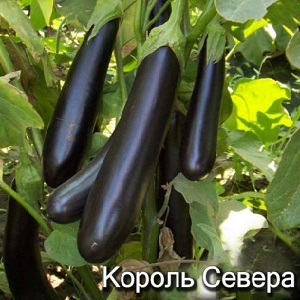 black bacterial spot;
black bacterial spot;- tobacco mosaic;
- late blight;
- gray rot.
Use against diseases biofungicides (for example, "Fitosporin") or Bordeaux liquid.
Eggplants are attacked by pests:
- aphids;
- slugs;
- bear;
- spider mites.
With a large number of insects, the bushes are treated with chemical agents (karbofos, "Strela", "Fitoverm").
About other varieties and hybrids of eggplant:
Growing eggplants "Mushroom taste"
Harvesting and application of the crop
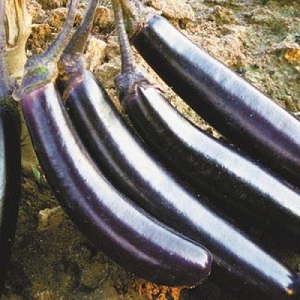 Eggplant is a delicious and low-calorie vegetable... Due to the high productivity of the hybrid, several bushes are enough to feed the whole family during the summer and prepare snacks for the winter.
Eggplant is a delicious and low-calorie vegetable... Due to the high productivity of the hybrid, several bushes are enough to feed the whole family during the summer and prepare snacks for the winter.
In summer, the fruits are stewed and fried... Serve separately with herbs and sauces or with cereals and other vegetables. Eggplants with grilled meat and salads are especially good. For dietary nutrition, boiled fruits are used.
For winter pickled vegetables and stew... Caviar, sauté, salads are prepared from them. Add to adjika and other blanks.
Fresh fruits are stored for up to 1 month in a cool room.... Chopped eggplants are frozen and kept in the freezer throughout the winter.
Advantages and disadvantages
The undoubted merits of the King of the North include:
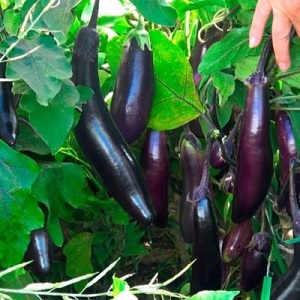 high cold resistance - the hybrid was bred for the northern regions, tolerates slight frosts;
high cold resistance - the hybrid was bred for the northern regions, tolerates slight frosts;- good germination of seeds;
- unpretentiousness - the bushes do not require additional care and can grow both in the greenhouse and in the open field;
- resistance to major diseases;
- classic taste without bitterness and versatility in cooking;
- commercial qualities - vegetables are well transported and stored for a long time;
- high productivity.
Disadvantages of a hybrid:
- has long fruits, which is inconvenient for growing and cooking;
- you can not use seeds from the harvested crop, you have to buy them annually;
- vegetables are simple to taste (some like more aromatic fruits).
Reviews
Below are the reviews of the farmers growing the King of the North eggplant on their site.
Anton, Nizhny Tagil: “For our conditions, the hybrid King of the North is a godsend. Always yields high yields of tasty fruits, does not require special care ".
Elena, Veliky Novgorod: “In the first year I planted a hybrid in a greenhouse and got a good harvest. Enough to eat in the summer and prepare for the winter. This year, I planted seedlings in open ground. There she felt great and gave the same harvest as in the greenhouse ".
Pavel, Kirov region: “The King of the North has a high harvest and interesting large fruits, but tasteless (all went to harvest). True, my wife liked the lack of bitterness ".
Conclusion
The King of the North is a hybrid that gives a high yield in the difficult climatic conditions of Siberia, the Urals and Transbaikalia. Does not require additional care, resistant to major diseases. It has properties unusual for culture: it does not like heat and abundant watering. Fruits without bitterness, do not require soaking, suitable for harvesting for the winter.